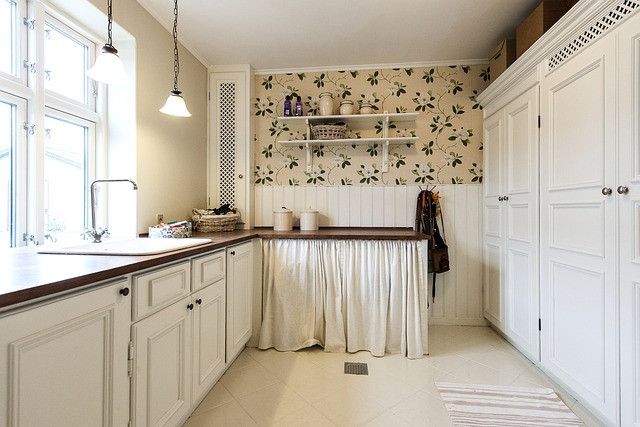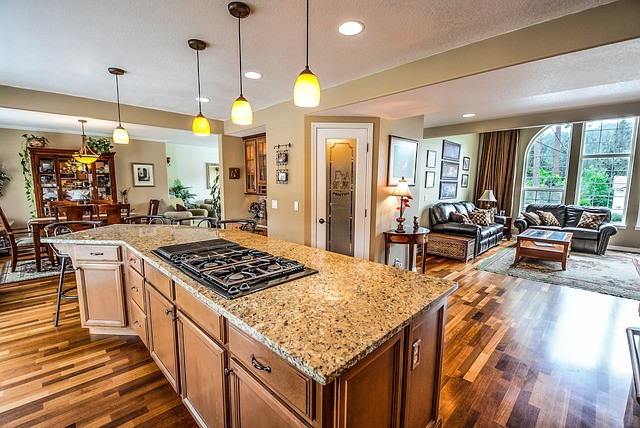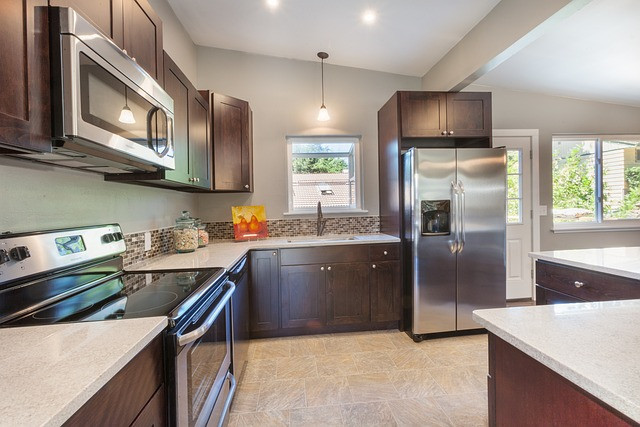
Are you ready to transform your small kitchen into a stylish and functional space?
In this article, we’ll guide you through the step by step small kitchen renovation process
From assessing the space to adding those final finishing touches, we’ll show you how to plan, demolish, update, and install everything needed for a successful kitchen remodeling project.
Get ready to roll up your sleeves and create the kitchen of your dreams!

Table of Contents
Assessing the Kitchen Remodel Space

Now that you’ve assessed the kitchen remodel space, it’s time to plan out the layout and design of the entire project.
Before diving into the renovation project, take a moment to envision your dream kitchen. Consider how you want to utilize the space, whether it be for cooking, entertaining, or both. Think about your storage needs and how many cabinets you’ll require.
The next step is determining if you need new flooring or if existing floors can be refinished. Choose materials that are durable and easy to clean.
When it comes to cabinet installation, think about functionality and aesthetics. Optimize storage space by incorporating pull-out shelves and organizers.
Related Article: small kitchen expert tips
Plan a Major Kitchen Remodel

First, you should start by considering a detailed plan for your major kitchen remodel, including the temporary kitchen setup. A well-thought-out plan will ensure that your kitchen remodeling project goes smoothly and efficiently.
Begin by deciding on the specific changes you want to make, such as installing new countertops or custom cabinets. This will help you create a clear vision for your renovation process.
Next, determine your budget and timeline for the project. Once these are established, you can move forward with hiring professionals, such as a general contractor or a kitchen designer, to install cabinets or countertops and begin the kitchen remodel process.
Don’t overlook flooring in your plan either, as it can significantly impact the overall look and functionality of your kitchen.
Related Article: Kitchen Renovation Services
Obtaining Permits For Kitchen Renovation

Obtaining building permits for your kitchen remodel project is essential for compliance with local building codes.
Research requirements, define your project scope, complete the building permit application, pay fees, and await approval.
Once approved, proceed with your renovation, ensuring adherence to the permitted plans and local regulations to ensure a safe and compliant project.
Related Article: kitchen renovation ideas
Demolition and Removal of Old Fixtures

Demolition begins with the skilled removal of old fixtures, clearing the way for the transformative journey of your kitchen remodeling process.
As the old cabinets, worn-out light fixtures, and outdated plumbing elements are carefully taken down and removed, you can envision the fresh canvas awaiting your vision. The installation of new cabinets, countertops, appliances, and other elements begins to shape your dream kitchen design.
Once the finish construction is completed, a final inspection ensures that every detail aligns with your expectations, and your newly remodeled kitchen is ready to shine.
Related Article: Kitchen Renovation Contractor
Updating Electrical and Plumbing Systems

Hiring professionals for the demolition and removal of old fixtures is a crucial step in updating your new kitchen, including your electrical and plumbing systems. When it comes to kitchen remodeling, ensuring that your plumbing fixtures and electrical work are up to code is essential for a safe and functional space.
A professional contractor can help you with roughing in the plumbing, which involves installing new pipes and drains for sinks, dishwashers, and other appliances. They can also handle the installation of new electrical outlets and wiring to accommodate updated appliances.
Whether you are planning a minor kitchen remodel or a complete overhaul of your kitchen, hiring a professional will ensure that all the necessary steps are taken, including properly installing drywall to protect your newly updated plumbing and electrical systems.
Installing New Cabinets and Shelving

Updating your kitchen cabinets and shelving is an effective way to enhance the functionality and aesthetics of your space. Here are four steps to guide you through the process of installing new cabinets and shelving in your kitchen renovation project:
Measure and plan: Take precise measurements of your existing kitchen cabinetry and assess your storage needs. This will help you determine the size, cabinet door style, and number of cabinets required for your remodel.
Order cabinets: Once you have a clear idea of what you need, order the cabinets that best suit your taste and budget. Consider factors like material, color, and hardware options to achieve the desired look.
Remove old cabinets: Before installing new ones, remove the existing cabinets carefully. Ensure proper disposal or recycling of any materials.
Install new cabinets: Follow manufacturer instructions or hire professionals to install your new cabinets securely. Take time to align them properly for a polished finished project.
Choosing and Installing New Countertops

Now that you have installed new cabinets and shelving in your small kitchen, it’s time to focus on choosing and installing new countertops.
This step is crucial in your kitchen remodel as countertops not only provide a functional workspace but also contribute to the overall aesthetic of your kitchen.
Start by considering the material options such as granite, quartz, or laminate, keeping in mind factors like durability, maintenance, and cost.
Once you have chosen the perfect countertop for your needs, it’s time to install it. Measure the dimensions accurately and ensure a proper fit before proceeding with installation.
Whether you choose to hire a professional or tackle the job yourself, make sure to follow manufacturer instructions carefully for optimal results. With your new countertops in place, your small kitchen renovation is one step closer to completion!
Selecting and Installing New Appliances

Once you’ve made your decisions on the type and style of appliances, it’s important to consider the installation process. Here are four key steps to help guide you through selecting and installing new appliances for your kitchen remodel:
Measure and plan: Before purchasing any new appliances, make sure to measure the available space in your kitchen. Consider the size and dimensions of each appliance to ensure a proper fit.
Research and compare: Take the time to research different brands, models, and features of new appliances. Compare their prices, energy efficiency ratings, warranties, and customer reviews to find the best options for your needs.
Order and schedule delivery: Once you have selected your desired appliances, place an order with a reputable retailer or manufacturer. Keep in mind that delivery times may vary depending on availability.
Prepare for installation: Clear out the area where the new appliances will be installed before they arrive. Ensure that all necessary utilities are properly connected and ready for use once installation is complete.
By following these steps, you can successfully select and install appliances as part of your kitchen remodel, ensuring that your new appliances are both functional and seamlessly integrated into your kitchen design.
Upgrading Light Fixtures and Options

To enhance the ambiance of your kitchen, consider upgrading your lighting fixtures and exploring different options available to you.
Upgrading your lighting fixtures is an important step in the kitchen renovation process, especially if you have a small kitchen. By upgrading your lighting fixtures, you can create a brighter and more inviting space.
Start by assessing the current lighting situation in your kitchen and determine what needs to be improved. Next, research different options such as pendant lights, recessed lighting, or under-cabinet lighting to find the best fit for your small kitchen.
Once you have chosen the right fixtures, it’s time to install them. Follow the manufacturer’s instructions or consult with a professional to ensure they are installed correctly. With upgraded lighting fixtures, your small kitchen will not only look better but also feel more spacious and functional.
Install Countertops and Flooring Materials

When upgrading your kitchen, it’s essential to install new countertops and flooring materials. This step is crucial in transforming your current kitchen into a more modern and functional space.
Here are four important things to consider during the installation process:
Choose the right countertop material: Whether you prefer granite, quartz, or laminate, select a material that suits your style and budget.
Measure accurately: Before purchasing the countertops and flooring materials, take precise measurements of your kitchen to ensure a perfect fit.
Hire professional help: Installing countertops and new flooring can be challenging if you don’t have experience. Hiring professionals will ensure a seamless installation process especially when you install flooring.
Coordinate with other renovations: If you’re undertaking other renovations in your kitchen, make sure to coordinate the installation of countertops and flooring materials accordingly.
Adding Stylish Backsplashes

Don’t forget to include stylish backsplashes in your typical kitchen remodel for an easy yet impactful aesthetic boost.
Tile backsplash, in particular, can swiftly elevate your kitchen’s look with added texture and visual appeal. Consider how the backsplash material complements your existing design elements, aiming for a cohesive look, especially if your kitchen features warm tones in the flooring or cabinets.
Installation is relatively straightforward, with online tutorials or expert guidance available. Ensure precise measurements and tile choices that seamlessly integrate with your cabinets for a polished finish, completing your kitchen renovation.
Painting or Refinishing Walls and Ceilings

You can easily transform the look of your kitchen by painting or refinishing the walls and ceilings. This simple step can make a big difference in giving your kitchen a fresh and updated look.
Here are 4 important things to consider when painting or refinishing your walls and ceilings:
Paint touch-ups: Before starting any major renovation, it’s always a good idea to do some paint touch-ups on the existing walls and ceilings. This will ensure that any imperfections are covered up and provide a smooth surface for the new finish.
Careful planning: Plan out your color scheme and decide whether you want to go with bold or neutral colors for your kitchen walls and ceilings. Consider how these colors will complement your cabinetry, countertops, and backsplash.
Licensed contractor: If you’re not confident in your DIY skills, it’s best to hire a licensed contractor who specializes in painting or refinishing. They will have the expertise to properly prepare surfaces, apply paint or finish, and ensure a professional result.
Construction zone: Remember that during this process, your kitchen will become a construction zone. Take necessary precautions to protect appliances, furniture, and flooring from dust or debris generated during the project.
Frequently Asked Questions
How Long Does the Entire Small Kitchen Remodel Project Usually Take?
Typically, the entire small kitchen renovation process takes about a few weeks. This timeline includes planning, demolition, and installation of new fixtures and appliances, as well as any necessary electrical and plumbing work.
What Are Some Budget-Friendly Options for New Countertops and Flooring Materials?
For budget-friendly options for new countertops and flooring materials, you can consider laminate or vinyl for the countertops, and vinyl or linoleum for the flooring. These options are cost-effective without compromising on style.
Can I Keep My Old Appliances and Still Achieve a Fresh Look in My Renovated Kitchen?
Yes, you can keep your old appliances and still achieve a fresh look in your renovated kitchen. Consider repainting or resurfacing them to match the new design, or incorporate them into the overall aesthetic.
Are There Any Eco-Friendly Options for Lighting Fixtures and Appliances?
Yes, there are eco-friendly options for lighting fixtures and appliances. You can choose energy-efficient LED lights and look for appliances with Energy Star certification to reduce your environmental impact while renovating your kitchen.
How Do I Ensure That My New Backsplash Complement the Overall Design of My Kitchen?
To ensure your new backsplash complements the overall design of your kitchen, consider coordinating colors and materials with your countertops and cabinets. Also, pay attention to the style and aesthetic you want to achieve for a cohesive look.
Conclusion

In conclusion, the step-by-step small kitchen renovation process provides a clear roadmap to transform your compact culinary space into a functional and stylish hub, whether it’s a minor remodel or a big project.
From careful planning and layout optimization to smart storage solutions and creative design choices, each step plays a vital role in maximizing the potential of your modern kitchens.
So, roll up your sleeves and embark on your kitchen renovation journey, knowing that with thoughtful execution, big results can be achieved in even the coziest of kitchens.

